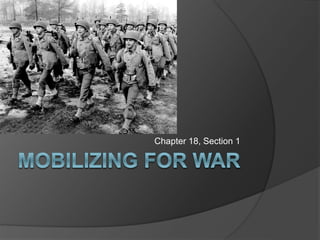
Mobilization for WWII
- 1. Chapter 18, Section 1
- 2. Setting the Scene As early as 1940, FDR was preparing citizens for war He said that Axis nations such as Germany posed a “direct threat to the security of the US” “We must be the great arsenal of democracy He asked businesses to support Britain’s defense efforts or face the possibility of war being waged on US soil
- 3. Setting the Scene FDR knew that the outcome of the war in Europe depended on the US’s ability to produce the following: Planes, tanks, guns, uniforms, and other war materials for the Allies
- 4. Mobilizing the Armed Forces FDR knew that building up the military was key Defense spending went from $2 billion to $10 billion in less than year September of 1940, Congress passed the Selective Training and Service Act Required all males aged 21 to 36 to register for military service A limited number of men would be selected from this pool to serve a year in the army
- 5. Four Freedoms FDR gave this speech, outlining the following freedoms that US troops would be fighting for: Freedom of speech and expression Freedom of every person to worship God in his own way Freedom from want (need) Freedom from fear This speech was given January 6, 1941
- 8. The GI War 16 million Americans served GI= “Government Issue” Far from home “What I’d give for a piece of blueberry pie”
- 9. Diversity and Gender in Military 300,000 Mexican Americans served in WWII 25,000 Native Americans 400 Navajo radio operators=“code talkers” 500,000 African Americans Until 1942, African Americans were limited in their role As casualties increased, they were now called into more active roles Mostly segregated units
- 10. Women 350,000 American women volunteered for military service Officials used women in all areas except combat Clerks, typists, airfield control tower operators, mechanics, photographers, drivers, and ferrying planes around the country
- 11. Preparing the Economy for War US entered war when production levels of the other Allies had dropped sharply British and Soviet production was affected by German bombing Japanese attacks in Pacific threatened to shut off rubber, oil, and tin supplies FDR pushed industries to move quickly into the production of war equipment
- 12. War Production January, 1942: gov’t set up the War Production Board Directed the conversion of peacetime industries into industries that produced war goods Halted production of civilian goods such as cars, lawn mowers, and many other products ○ Ford Motor Company built B-24 bombers instead of cars, for example Armed forces decided which companies would receive contracts to manufacture military hardware
- 13. Office of War Mobilization Served as a super-agency in the centralization of resources Led by James Byrnes: he was often called the “assistant president” due to his decision-making powers Some said Byrnes ran the country while FDR ran the war
- 14. Business Incentives Government established “cost-plus” system for military contracts with businesses Military paid development and production costs Also added a percentage of costs as profit for the manufacturer
- 15. Production Levels By 1945, the US had produced: 300,000 airplanes 80,000 landing craft 100,000 tanks and armored cars 5,600 merchant ships 6 million rifles, carbines, and machine guns 41 billion rounds of ammunition WOW! That’s a lot of production! “There’s a war on you know!”
- 16. Wartime Work Force Massive unemployment levels dropped due to need to produce! Wages greatly increased as well (50%) Union membership rose again: 1.5 million workers joined unions in 1941 14.8 million total workers in unions Workers and employers agreed to no strikes during war But as cost of living went up, strikes were more common due to wages not matching the COL
- 17. How does the US pay for the War? US Gov’t vowed to “spend whatever was necessary” to sustain the war effort Federal spending went from $8.9 billion in 1939 to $95.2 billion in 1945 GNP more than doubled in that time Overall spending of federal gov’t between 1941-1945 was about $321 billion This was 10X as much as was spent for WWI
- 18. How does the US pay for the War? Higher taxes paid for 41% of war costs US Gov’t borrowed the rest of the money from banks, private investors, and general public The US Treasury issued bonds to help finance war, which brought in $186 billion National debt went from $43 billion in 1940 to $259 billion in 1945
- 19. Daily life on the Home Front 30 million moved during war Population grew by 7.5 million, high birth rate, start of the “Baby Boom” Better spirits w/ end of Depression
- 20. Daily life on the Home Front Rationing of goods were put in place Other items were just not available Metal, nylon, rubber Food supply was short of the demand Supplies of sugar, tropical fruits, and coffee were cut off due to enemy occupation of foreign countries
- 21. Office of Price Administration Set up in April 1941 It’s job was to control inflation by limiting prices and rents Overall, the OPA was successful for the most part: cost of living rose, but not as bad as in WWI Also oversaw rationing of goods such as: Meat, butter, sugar, coffee, canned fruit, shoes, gas Consumers had coupon books with points to use
- 22. WWII Propaganda